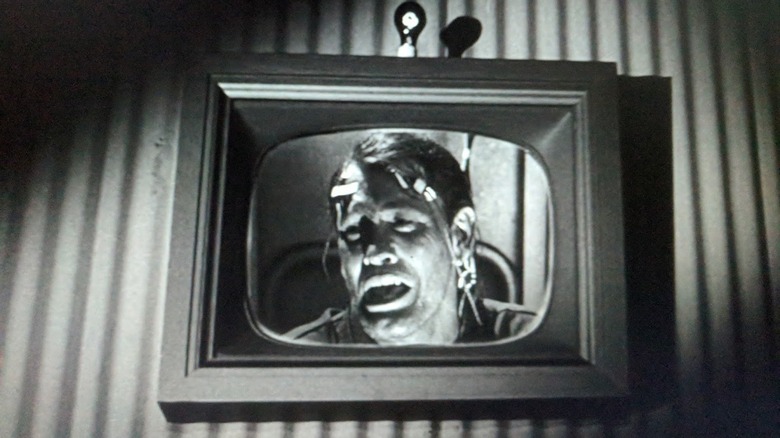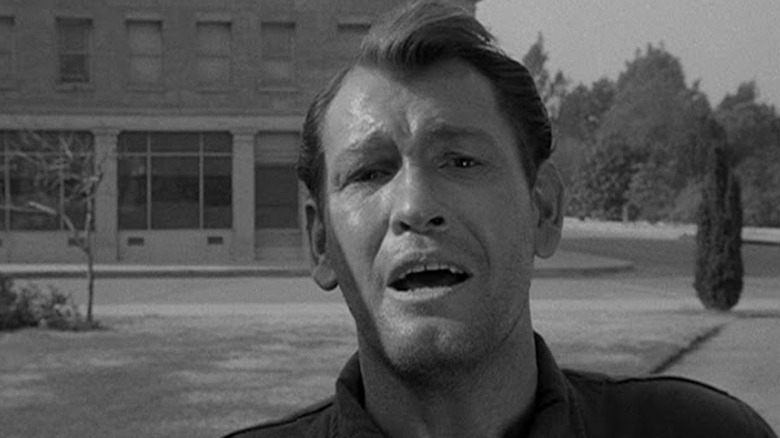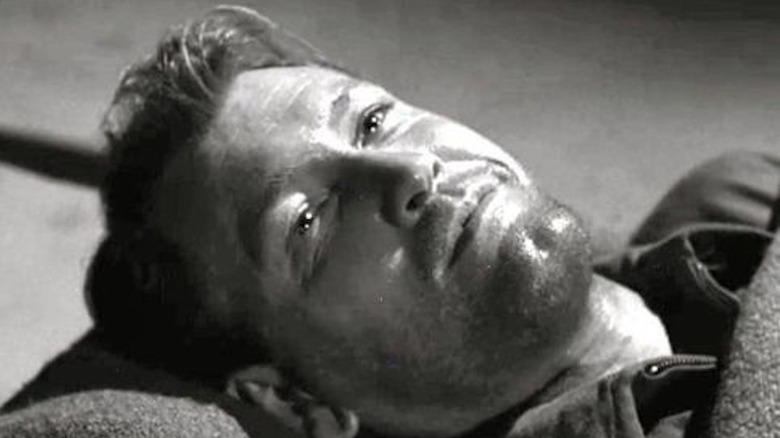How The Twilight Zone (Kind Of) Predicted Neil Armstrong's Landing On The Moon
64 years after its debut on CBS, no series has been able to match the consistency of quality or the rigorousness of thought that Rod Serling's "The Twilight Zone" demonstrated over its five stellar seasons. For many, the series' most memorable episodes set us on edge via science fiction or straight-up horror elements (e.g. "To Serve Mankind," "Living Doll" and "Nightmare at 20,000 Feet"), but Serling and his roster of first-rate writers (Richard Matheson, Charles Beaumont, and George Clayton Johnson) could be just as brilliant when using nothing but plain old reality to freak us out.
The Red Scare metaphor "The Monsters Are Due on Maple Street" is probably the finest example of this (especially in an era where a massive blackout could easily plunge millions of technology reliant humans into utter chaos), but it's closely followed by the pilot episode that established the series as a one-of-a-kind mindf***. Written by Serling himself, "Where Is Everybody?" sets up as a post-apocalyptic nightmare. Earl Holliman plays an amnesiac who finds himself wandering an eerie unpopulated town; he has no idea where he is or how he got there, and is doubly unnerved there's no one around to confide in.
As he explores the town square (yes, that's the famous Universal Courthouse Square that's probably most recognizable to today's viewers as Hill Valley from "Back to the Future"), he becomes increasingly anxious for human connection. He tries to make an outgoing call on a public phone, but only gets a recorded message informing him that the number he dialed is out of service. He enters a deserted police station and tries to raise officers on the radio, but there's nothing.
A fact-based piece of science horror
There is evidence that people have been in the town recently, but they've all inexplicably vanished. Holliman also feels as if he's being watched. At this point of the episode, you figure you're securely in the realm of science fiction or, perhaps, the supernatural. That's when Serling pulls a sucker punch that was more realistically prescient than anyone could've imagined at the time.
When Holliman frantically presses a crosswalk button, he discovers he has indeed been under observation — in a sensory deprivation chamber. He's an astronaut who's been isolated from the outside world for 20 days as a means of simulating his ability to withstand a solo mission to the moon. Again, this episode aired in 1959, which was two years prior to Alan Shepard first Mercury flight. Most amazingly, it was 10 years removed from the Apollo moon landing. And if you think Serling made a lucky prediction, you are, of course, incredibly wrong.
Don't go away. We'll be up there in a little while.
As noted in a 2019 New York Times piece linking "Where Is Everybody?" to the 60th anniversary of Neil Armstrong making "one giant leap for mankind," journalist Thomas Vinciguerra recalled that Serling was inspired by a 1958 Time Magazine article about NASA subjecting potential astronauts to isolation chamber experiments.
He used that to turn the inspiring prospect of landing on the moon into a nightmarish proposition. At the end of the episode, Holliman is informed that the next time will be for real; he'll be all by himself on that barren gray orb. As the future astronaut is carried out of a hangar on a stretcher (to the spine-tingling strains of Bernard Herrmann's score), he looks skyward and, with an unnerving smile, says "Hey! Don't go away up there! Next time it won't be a dream or a nightmare. Next time it'll be for real. So don't go away. We'll be up there in a little while."
As Holliman told Vinceguerra in 2019, "Less than a decade later, a billion people on Earth heard Neil Armstrong say, 'That's one small step for man, one giant leap for mankind.' Promise made, promise kept. Rod made the promise, he kept it — and welcome to 'The Twilight Zone.'"
And if you think Apollo 11 was a pleasure cruise, watch Damien Chazelle's nerve-jangling "First Man," which strips Armstrong's experience of wonder and, at times, captures the horror of Serling's classic.


